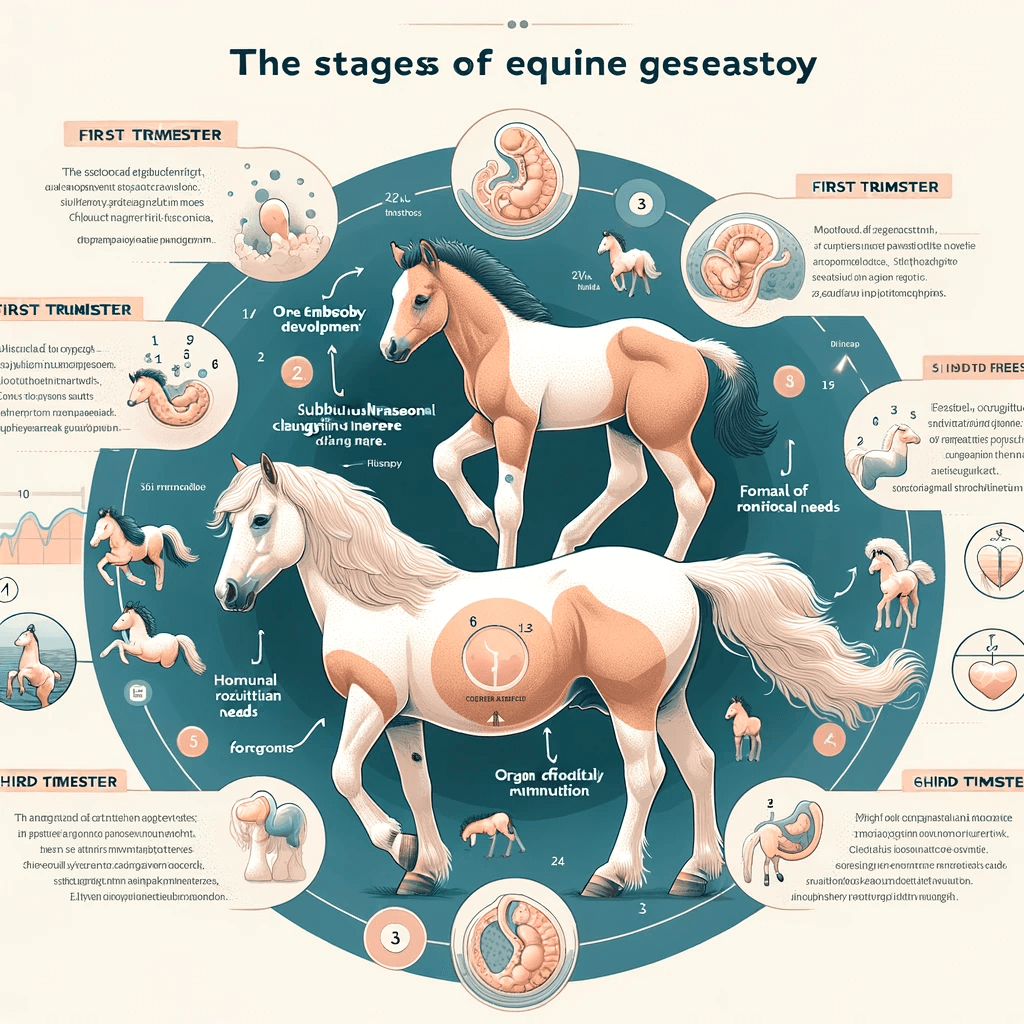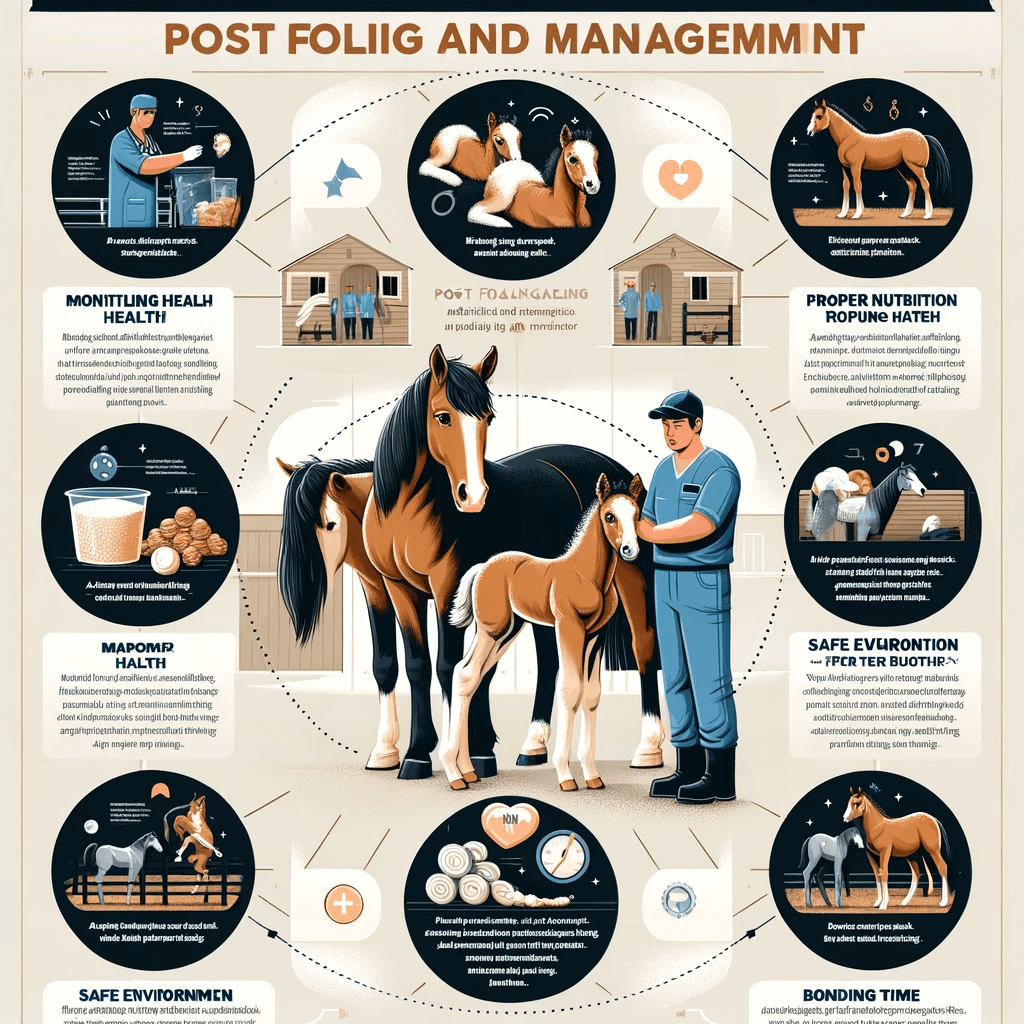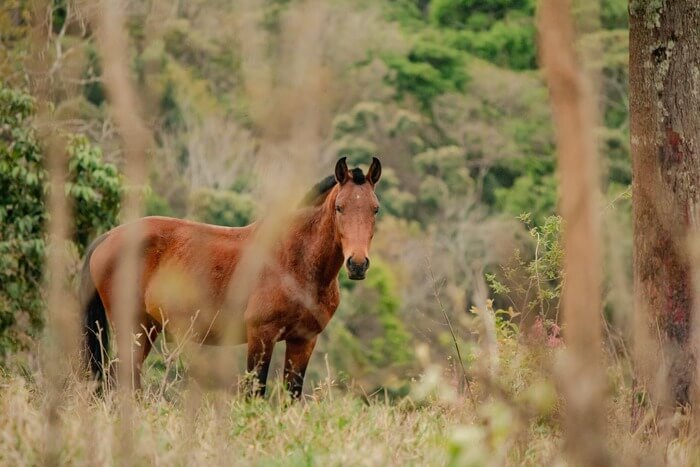Introduction:
The miracle of birth is a remarkable event in the equine world, where the gestation period is a testament to nature’s intricacies. Understanding the duration and process of horse breeding is crucial for breeders, veterinarians, and horse enthusiasts alike.
The length of a horse’s pregnancy can vary, influenced by several factors including breed, age, health, and environmental conditions. This article will gallop through the fundamentals of equine gestation, exploring the typical timelines and what one can expect during this majestic period.
Read More: Exploring the World Through Horse Vision: Key Insights
Understanding Equine Gestation: An Overview
Equine gestation is a marvel of the natural world, a period of profound transformation and anticipation. For horse breeders, understanding the nuances of this process is critical for ensuring the health and well-being of both the mare and her foal. The typical horse pregnancy lasts for about 340 days, but it’s not uncommon for gestation to range from 320 to 360 days, depending on individual circumstances. This duration allows for the full development of the foal, preparing it for life outside the womb.
Gestation length can be influenced by breed, with larger horses tending to have longer pregnancies than smaller breeds. Seasonal variations also play a role; foals born in the spring benefit from better weather and more abundant resources. Mares often carry colts (male foals) slightly longer than fillies (female foals), and first-time mothers may also have shorter gestation periods.
Throughout this gestational journey, mare owners must be vigilant in observing their horses for any signs of distress or complications, as timely intervention can be crucial. Regular veterinary check-ups, proper nutrition, and a safe environment are essential for the mare as she carries her precious cargo to term.
Read More: Horse Lameness: Causes, Diagnosis, & Management

The Early Stages of Pregnancy: The First Trimester
The first trimester of a horse’s pregnancy is a time of foundational development. Within the first few weeks, the embryo travels to the uterus and implants itself – a critical step where pregnancy can be most vulnerable to failure. By day 16 post-ovulation, the embryo becomes visible via ultrasound, a practice used by veterinarians to confirm pregnancy and monitor the embryo’s health.
In this initial trimester, the embryo develops into a fetus with a beating heart and the beginnings of what will become the skeletal structure. Hormonal changes in the mare can be subtle, but they’re pivotal in sustaining the pregnancy. Some mares may show slight behavioral changes or experience morning sickness similar to humans, although this is less commonly observed or reported.
Care for the mare during this period doesn’t dramatically change, but it should be attentive. It’s important to continue with light to moderate exercise and maintain a well-balanced diet that supports early pregnancy. Stress is a known factor that can compromise the stability of pregnancy, so providing a calm and stable environment is essential.
Read More: Fastest Horse in the World: A Gallop Through Time and Records
Milestones in the Mare: The Second Trimester
Entering the second trimester marks a significant phase in the mare’s pregnancy. The fetus undergoes rapid growth and development. The critical organs have formed, and the fetus now looks distinctly equine, with the development of facial features, limbs, and hooves.
During this period, the mare’s nutritional needs will increase to support the growing fetus. She may begin to gain weight more noticeably, and her abdomen will slowly enlarge as the foal takes up more space. Monitoring the mare’s body condition is important; she should gain weight steadily but not become overweight, which can lead to complications during foaling.
Veterinary care remains crucial, with check-ups focusing on the health of the fetus and the prevention of any complications. The second trimester is also a time when vaccinations are typically updated to protect the mare against diseases that could affect the foal, with the antibodies being passed on via the placenta.
The mare’s exercise regime should still continue, albeit adjusted to accommodate her changing body and to ensure she remains fit without causing undue stress. This balance helps prepare her for the delivery process while keeping the fetus healthy.
Read More: Where Do Horses Come From: A Journey Through Equine Origins
The Final Countdown: The Third Trimester
As the mare enters the third trimester of her pregnancy, the foal undergoes its most critical period of growth and development. The final three months are when the foal gains the most weight, and its organs mature to prepare for life outside the womb. During this stage, the mare’s nutritional requirements will peak to support the rapid growth of the foal. It’s important to provide a diet rich in quality forage, balanced with the appropriate levels of protein, vitamins, and minerals, particularly calcium and phosphorus for the developing bones of the foal.
The mare’s abdomen becomes significantly larger, and her behavior may change as she carries the extra weight of the nearly fully-formed foal. Exercise is still beneficial, but intensity should be significantly reduced to prevent any strain on the mare and the foal. Close observation is essential; as the due date approaches, breeders and caretakers should watch for any signs of discomfort or health issues that may necessitate veterinary attention.
As the countdown to foaling begins, preparations should be made for the birthing process. A clean, quiet, and safe environment is vital for a successful delivery. The bedding should be ample and clean to provide a comfortable area for the mare to give birth.
Read More: Exploring Careers with Horses: What Jobs Involve Horses?
Factors Influencing Gestation Length
While the average horse gestation lasts about 340 days, several factors can influence this duration:
Breed:
Certain breeds may carry a foal for a shorter or longer period. For instance, ponies tend to have shorter gestation periods compared to larger breeds like draft horses.
Age:
Older mares might have slightly longer gestation periods than younger ones.
Health:
The overall health of the mare can impact the length of pregnancy. Mares in optimal health are more likely to have a gestation period within the normal range.
Season:
Foals born during the early spring months may benefit from better weather conditions, and there is evidence that mares will naturally time the birth of their foals to these optimal conditions.
Foal Sex:
It’s been observed that mares may carry male foals (colts) slightly longer than female foals (fillies).
Nutrition:
Poor nutrition can lead to a variety of issues, including an altered gestation length.
Read More: Strangles in Horses: Symptoms, Treatment, and Prevention
Recognizing Signs of Impending Foaling
As the mare reaches the end of her pregnancy, certain signs can indicate that foaling is imminent:
Udder Development:
About 2-6 weeks before foaling, the mare’s udder will begin to fill with milk.
Relaxation of the Pelvic Ligaments:
The muscles around the mare’s tailhead will soften and appear more relaxed as her body prepares for birth.
Waxing of the Teats:
A waxy substance may form on the teats a few days before birth, signaling that labor is close.
Milk Droplets:
Milk may begin to drip from the teats as the due date approaches.
Behavioral Changes:
Some mares may show signs of restlessness, isolation from the herd, or other behavioral changes.
Appetite Loss:
A mare might lose her appetite 24-48 hours before foaling.
Recognizing these signs is crucial for ensuring that the mare is in a safe and prepared environment for the birthing process. It allows the caretaker to monitor the mare more closely and be on alert for any complications that could require immediate veterinary assistance.
Read More: When Horses Reach Full Size: A Guide to Equine Growth
The Role of Nutrition in Horse Pregnancy
Nutrition plays a pivotal role in the success of a horse’s pregnancy. From conception to foaling, the nutritional needs of a mare must be carefully managed to ensure the health and proper development of the foal, as well as to maintain the mare’s condition throughout the gestation and post-foaling. In the first two trimesters, the mare’s diet should support her own body condition without overfeeding, as excessive weight can lead to complications. By the third trimester, her energy intake should increase by about 30-50% to accommodate the rapid growth of the foal.
High-quality forage should form the foundation of a pregnant mare’s diet, supplemented with a balanced mix of proteins, vitamins, and minerals. Essential nutrients such as Vitamin E, selenium, and omega-3 fatty acids are vital during pregnancy. It’s also important to provide adequate amounts of clean, fresh water to support increased blood volume and to help transport nutrients to the developing foal.
Read More: Why Do Horses Like Sugar Cubes: Unveiling the Sweet Secret
Managing the Pregnant Mare: Exercise and Care
Moderate exercise is beneficial for pregnant mares as it can help prevent excessive weight gain and reduce the risk of colic and other health issues. Light riding or turnout in a paddock allows the mare to move freely and maintains muscle tone, which aids in the birthing process. However, as the mare enters the final trimester, exercise should be less intense and carefully monitored to avoid stress or injury.
Regular grooming and hoof care are also part of managing a pregnant mare, helping to promote circulation and overall well-being. Stress reduction is another important aspect of care; a calm and consistent routine should be maintained, with any necessary changes introduced gradually.
Complications and Veterinary Care During Gestation
While many mares will have an uneventful pregnancy, some may experience complications such as miscarriage, premature labor, or dystocia (difficult birth). Early detection and intervention are key, and this is where consistent veterinary care comes into play. Regular check-ups can help identify and manage issues such as placentitis (inflammation of the placenta), which can threaten the foal’s life.
Ultrasounds and other diagnostic tools allow veterinarians to monitor the foal’s development and the health of the mare throughout pregnancy. A vaccination schedule should be followed as recommended by the vet to protect both mare and foal from infectious diseases.
Breeding Considerations and Timing
Strategic planning is crucial when breeding horses. The goal is often to time the birth of the foal for early in the year, particularly in breeds associated with racing, where age is calculated from January 1st. However, considering the mare’s natural cycle and health is also important. Mares are seasonally polyestrous, meaning they have multiple estrous cycles during the spring and summer months.
Breeding should ideally occur during this natural fertile period for the best chance of conception. Understanding the mare’s cycle through vet exams and hormone tracking can pinpoint the optimal time for breeding. Additionally, the mare’s age, health status, and previous reproductive history should be taken into account when planning to breed.
Post-Foaling Care and Management

Initial Health Assessments: A Critical First Step
Right after birth, it’s essential to evaluate the foal’s breathing and heart rate, and check the mare for any post-delivery complications. This immediate health check sets the stage for a healthy start.
The Power of Colostrum: Building the Foal’s Immunity
Colostrum, the mare’s first milk, is packed with antibodies. Ensuring the foal ingests colostrum within the first few hours is vital for developing a robust immune system.
Nutritional Focus: Supporting the Mare’s Recovery
Post-foaling, the mare requires a well-balanced diet to recover from childbirth and to produce nutritious milk for her foal. This period demands heightened attention to her nutritional needs.
Monitoring for Complications: Vigilance is Key
Watch for signs of postpartum issues in the mare, such as retained placenta or infection. Early detection and intervention can prevent more serious health problems.
Bonding and Early Feeding: The Foundation of Growth
Observing the mare and foal’s bonding and ensuring the foal starts feeding properly are fundamental for their mutual well-being. These early interactions lay the groundwork for the foal’s development.
First Steps and Veterinary Checks: Tracking Progress
In the initial days, veterinary visits are important for the foal’s health assessment, starting a vaccination and deworming schedule, and monitoring its overall development.
Creating a Nurturing Environment: Safety and Comfort
Providing a calm, secure environment is essential for the new mother and her baby. This encourages a strong bond and allows the foal to explore and grow in a stress-free setting.
Conclusion:
The gestation period in horses is a protracted and complex process that requires careful management and understanding. While the average horse pregnancy lasts around 340 days, it is essential to recognize the variability and the signs that each mare may exhibit as she approaches foaling.
Meticulous care, a proper diet, and regular veterinary check-ups are key to ensuring the health and well-being of both the mare and her offspring. By monitoring and supporting the mare throughout her pregnancy, breeders can look forward to the joyous arrival of a new foal.
FAQs:
Can you tell if a mare is pregnant just by looking at her?
In the early stages of pregnancy, it is not possible to tell if a mare is pregnant just by looking at her. As the pregnancy progresses, physical changes will become apparent, but a veterinary examination is the most reliable way to confirm pregnancy.
How soon can a pregnancy test be done on a mare?
A veterinarian can perform an ultrasound to detect pregnancy as early as 14 days post-ovulation, with more definitive results at 28 days.
Do mares have a set due date like humans?
Mares do not have a set due date. The gestation period can range from 320 to 360 days, with an average around 340 days.
What is the longest recorded horse pregnancy?
There have been instances where a mare’s pregnancy has exceeded 360 days, but these are exceptions rather than the norm. Extended pregnancies should be monitored closely by a veterinarian.
Can a mare go into labor early?
Yes, mares can go into labor early, which is known as premature foaling. It’s less common and can pose health risks to the foal, so veterinary intervention is important.
